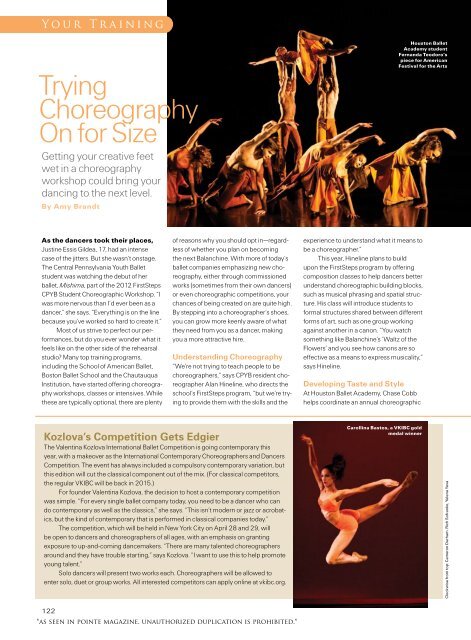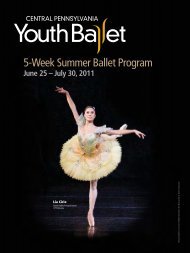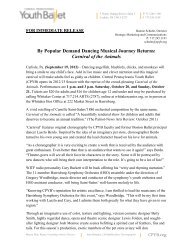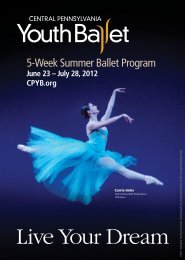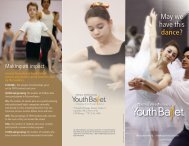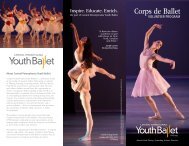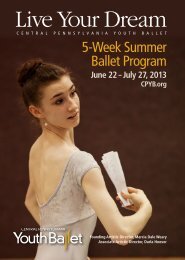Your Training - Central Pennsylvania Youth Ballet
Your Training - Central Pennsylvania Youth Ballet
Your Training - Central Pennsylvania Youth Ballet
Create successful ePaper yourself
Turn your PDF publications into a flip-book with our unique Google optimized e-Paper software.
<strong>Your</strong> <strong>Training</strong>TryingChoreographyOn for SizeGetting your creative feetwet in a choreographyworkshop could bring yourdancing to the next level.By Amy BrandtHouston <strong>Ballet</strong>Academy studentFernanda Teodoro’spiece for AmericanFestival for the ArtsAs the dancers took their places,Justine Essis Gildea, 17, had an intensecase of the jitters. But she wasn’t onstage.The <strong>Central</strong> <strong>Pennsylvania</strong> <strong>Youth</strong> <strong>Ballet</strong>student was watching the debut of herballet, Mishima, part of the 2012 FirstStepsCPYB Student Choreographic Workshop. “Iwas more nervous than I’d ever been as adancer,” she says. “Everything is on the linebecause you’ve worked so hard to create it.”Most of us strive to perfect our performances,but do you ever wonder what itfeels like on the other side of the rehearsalstudio? Many top training programs,including the School of American <strong>Ballet</strong>,Boston <strong>Ballet</strong> School and the ChautauquaInstitution, have started offering choreographyworkshops, classes or intensives. Whilethese are typically optional, there are plentyof reasons why you should opt in—regardlessof whether you plan on becomingthe next Balanchine. With more of today’sballet companies emphasizing new choreography,either through commissionedworks (sometimes from their own dancers)or even choreographic competitions, yourchances of being created on are quite high.By stepping into a choreographer’s shoes,you can grow more keenly aware of whatthey need from you as a dancer, makingyou a more attractive hire.Understanding Choreography“We’re not trying to teach people to bechoreographers,” says CPYB resident choreographerAlan Hineline, who directs theschool’s FirstSteps program, “but we’re tryingto provide them with the skills and theexperience to understand what it means tobe a choreographer.”This year, Hineline plans to buildupon the FirstSteps program by offeringcomposition classes to help dancers betterunderstand choreographic building blocks,such as musical phrasing and spatial structure.His class will introduce students toformal structures shared between differentforms of art, such as one group workingagainst another in a canon. “You watchsomething like Balanchine’s ‘Waltz of theFlowers’ and you see how canons are soeffective as a means to express musicality,”says Hineline.Developing Taste and StyleAt Houston <strong>Ballet</strong> Academy, Chase Cobbhelps coordinate an annual choreographicKozlova’s Competition Gets EdgierThe Valentina Kozlova International <strong>Ballet</strong> Competition is going contemporary thisyear, with a makeover as the International Contemporary Choreographers and DancersCompetition. The event has always included a compulsory contemporary variation, butthis edition will cut the classical component out of the mix. (For classical competitors,the regular VKIBC will be back in 2015.)For founder Valentina Kozlova, the decision to host a contemporary competitionwas simple. “For every single ballet company today, you need to be a dancer who cando contemporary as well as the classics,” she says. “This isn’t modern or jazz or acrobatics,but the kind of contemporary that is performed in classical companies today.”The competition, which will be held in New York City on April 28 and 29, willbe open to dancers and choreographers of all ages, with an emphasis on grantingexposure to up-and-coming dancemakers. “There are many talented choreographersaround and they have trouble starting,” says Kozlova. “I want to use this to help promoteyoung talent.”Solo dancers will present two works each. Choreographers will be allowed toenter solo, duet or group works. All interested competitors can apply online at vkibc.org.Carollina Bastos, a VKIBC goldmedal winnerClockwise from top: Cameron Durham. Rich Sofranko, Yelena Yeva122*as seen in pointe magazine. unauthorized duplication is prohibited.*
collaboration between summer intensivedancers and student composers from theAmerican Festival for the Arts. “When youchoreograph, you’re asked to qualify everychoice that you make, distill it down intotangible ideas and then communicate it tosomebody else,” he says. “The experiencereally helps hone students’ communicationskills and solidify their ideas as artists.”For many students, the process starts byresearching favorite choreographers to helpthem formulate ideas and discover their ownartistic taste. For his duet Discovery and theLike, Houston <strong>Ballet</strong> Academy student JamesPotter, 16, turned to Mats Ek. “A lot of his workhas a domesticated, homey feel that’s totallyrelatable,” says Potter. “I wanted to incorporatethat same feel in my work.”Most schools use a hands-off approachto choreography, allowing students to createwhatever they like and cultivate a personalworking style. “Some dancers come in andhave all the steps mapped out,” says Hineline,“while others are freer in their process.” Eitherway, students learn that flexibility is key, asideas often change. For instance, AlexanderManning, a CPYB alum now apprenticing withMiami City <strong>Ballet</strong>, discovered that phrases thatfelt comfortable on his male frame sometimeslooked laborious on his all-female cast.Gaining Leadership SkillsChoreography classes can also take dancersto a new level of personal growth: Not onlyare you forced to dig deep creatively, but youdevelop time management, organizationaland leadership skills. No longer focused ontheir own dancing, students must take chargeof the room and sensitively gauge the workhabits of others while staying on course. “IClass onthe RoadWant to take class while you’reon tour or vacation? Downloadthe On Point Dance app for youriPhone, iPad or iPod touch. Youcan search 16 major cities tosee a list of daily class schedulesat all nearbydance schools.Quickly scrollfrom schoolto school andcompile yourown list of thebest offerings.The programcosts 99 centsin iTunes.You grow keenly awareof what choreographersneed from you.didn’t want to be rude, but I didn’t want to be solenient that the piece didn’t turn out well,” saysGildea. Receptive dancers with a willingness tocollaborate proved especially valuable to herduring the process. “Next time I work with achoreographer, I want to be the same way.”Showing your piece and listening tofeedback is common during choreographicworkshops. “It’s very exposing,” says Cobb,“but it allows the choreographers to stepback a bit and see their work for its full value.”For instance, after faculty members advisedPotter to create more emotional connectionsbetween his dancers, he spent the remainingrehearsal period developing their characterizations.Learning to take critiques aboutsomething you’ve created can be one of themost challenging parts of the process, but itbuilds maturity that can translate back to yourdance life.A Choreographer’s DancerMany students say that participating in achoreographic workshop opened their eyes asartists. “It changed how I watched ballet,” saysManning, who used to focus primarily on thedancers. Now, he sees the bigger picture, frommusic to lighting to spacing. Experiencing theamount of effort choreographers pour intotheir work—and knowing firsthand what theyneed—allows you, as a dancer, to approachyour work more creatively and intelligently.“Now that I’m back on the other side,” saysManning, “I want to be that inspiring, hardworking,collaborative dancer they look for.” PTechnique Tip“I sometimes hold a pen (actuallya skinny makeup brush!) betweenmy pointer, middle and ring fingersfor a few combinations at barre. Ithelps me feel my fingers so that Ican create a beautiful shape withmy hands throughout the day.”—Pittsburgh <strong>Ballet</strong> Theatreprincipal Julia EricksonDANCE AUDITION TOUR2014New York City, NY Jan. 3Boston, MA Jan. 4Sign up for ourWashington D.C.* Jan. 5FREEPortland, ME Jan. 6Denver, CO Jan. 9San Francisco, CA* Jan. 11Seattle, bi-weeklyWA Jan. 12E-newsletter!Los Angeles, CA Jan. 16Austin, TX Jan. 17Atlanta, GA Jan. 19Chicago, IL Jan. 18Detroit, MI* Jan. 21Ann Arbor, MI Jan. 22Cincinnati, OH Jan. 23Grand Rapids, MI Jan. 24Indianapolis, IN Feb. 2*Dance, Theatre and Music AuditionsSUMMER PROGRAMSSUMMER ARTS CAMP • 3-6 weeksOne week summer intensiveFINE ARTS BOARDING HIGH SCHOOLGrades 9 - 12 • September - MayFor up to date audition information, please visit us at:pointemagazine.comwww.interlochen.org/dance2014YHc


